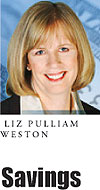Wendi Pendleton was living pretty much paycheck to paycheck when she read one of my columns telling people they need $500 in the bank. Having a big emergency fund is great, I wrote, but all you need to get started on a better financial future is a $500 pad. That’s enough to avoid bounce fees, steer clear of payday lenders and cover most minor emergencies.


Wendi Pendleton was living pretty much paycheck to paycheck when she read one of my columns telling people they need $500 in the bank.
Having a big emergency fund is great, I wrote, but all you need to get started on a better financial future is a $500 pad. That’s enough to avoid bounce fees, steer clear of payday lenders and cover most minor emergencies.
"I decided it was solid advice and trimmed my spending that month and saved $500,” Wendi wrote me. "Realizing how much money I wasted, I saved another $500 the next month, and so on.”
Some months she saved even more. Unexpected dental work and a car repair, events that would have stressed her out in the past, didn’t derail her.
"I now have $12,000 in savings I am using as a down payment on my first house, something I never thought would be possible for me on my own,” Wendi wrote from Riverside, Calif.
Most of the talk about financial cushions centers on the importance of an emergency fund, that stash of cash that’s supposed to equal three to six months’ worth of expenses. That’s an awfully tough standard for most families to meet.
A $500 pad, by contrast, is something that just about everyone can scrape together with enough determination. And it can change your life.
3 steps to a $500 cushion
1. Start by keeping an extra $100 in your checking account. If you maintain this pad and resist the urge to spend it, you’ll greatly reduce your chances of bouncing a check.
2. Then funnel $400 into your savings account. It may not seem like much, but $400 will cover a good chunk of the real emergencies that come your way, from car repairs to replacing an appliance that breaks down.
Even if an unexpected expense is higher than $400, you’ll at least reduce the amount you need to scrape up from other sources.
3. Then leave it alone unless you’re facing a real emergency. If you’re in credit card debt or owe money to payday lenders, you must get out of the habit of looking for a quick fix when you encounter unexpected expenses.
The pain of taking money out of savings may help you look for alternatives to spending the cash. If the spending is absolutely necessary, you’re better off paying cash than paying interest on money borrowed from credit cards or payday lenders. Then you can concentrate on rebuilding your cushion as soon as possible.
The first $500 is the hardest
Eventually, you should try to build your pad of cash into a real emergency fund, although that can come after you’ve taken care of more-pressing financial needs, such as paying off high-rate debt and saving for retirement.
Here are some ideas for scraping up the initial $500:
• Try a "buy nothing” month. Several dozen posters on the Your Money message board have tried this experiment, and many are surprised at the amounts of cash they’re saving by buying only necessities for a single month. If you bring your lunch and snacks to work, don’t eat out and avoid shopping for 30 days, you may find you can make a good deal of progress toward your $500 goal.
• Save your change. Several readers tell of saving hundreds of dollars over the course of a year, even making a game of it with their children.
• Review your bills. If you haven’t already, go through your regular bills and see what you can trim. Dropping premium TV channels or doing without pay TV entirely for a while could produce significant savings.
Phone bills are often rife with extras that can be cut. If you have high-speed Internet access, consider switching to an Internet calling service such as Vonage or Skype to save even more. Once you’ve trimmed, channel the extra savings into your bank account. If you save $10 on your phone bill, for example, put that much into savings each month.
• Make your savings automatic. Setting up a regular electronic transfer from your checking to your savings account is much better than making the transfers manually.
If you have to make the decision to save every month, you’ll probably decide to do something else with the money. If the decision is made for you, it’s more likely to stick.
But is it an emergency?
If you’ve been living paycheck to paycheck for a while, you may be unclear about what constitutes a true emergency. Essentially, it’s an event that puts your livelihood or you family’s safety at risk. The television dying, for example, is not. an emergency.
A car repair may or may not be an emergency, depending on whether you have alternate transportation. If you can’t get to work any other way, then getting the car fixed justifies raiding your emergency fund. If you can take the bus for a while, it doesn’t.
Regular, predictable expenses are not emergencies. Neither are gift-giving occasions such as weddings, holidays and birthdays.
Liz Pulliam Weston is the Web’s most-read personal-finance writer. She is the author of several books, most recently "Your Credit Score: Your Money & What’s at Stake.”


